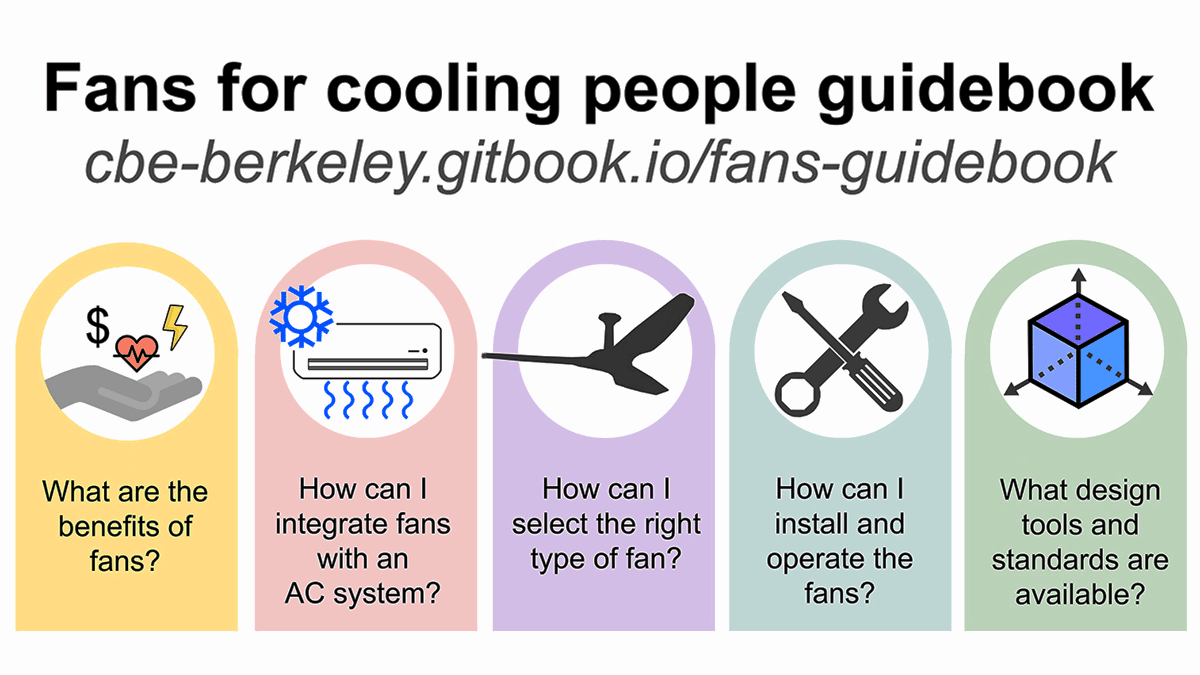Comprehensive guide for practitioners on design and implementation of fans and fan-integrated systems
Fans for Cooling People Guidebook
Status: Completed
Funding Sources: CBE Industry Consortium Republic of Singapore's National Research Foundation
Project Objective
Using fans alone or in coordination with HVAC systems to cool people offers several significant enhancements compared to conventional HVAC systems, including improved thermal comfort, indoor air quality, air distribution, energy savings, and initial cost savings. Despite the numerous benefits of fans and fan-integrated systems, comprehensive resources have previously been unavailable to guide engineers and architects in designing and implementing such systems. The purpose of this guideline is to address this gap and provide practitioners with valuable materials and answers to common questions.
Project Results
This guideline can assist users in selecting suitable fan types based on individual building characteristics and specific application needs, and provides an overview of the many criteria for fan selection. These criteria cover blade characteristics, fan size, airflow patterns, fan performance metrics, motors and drives, power and efficiency, and control strategies. This guidebook also discusses how HVAC systems can be integrated with fans to derive maximum benefits for energy efficiency and comfort.
With well-defined design intent, the guidebook provides a step-by-step process for determining the number and size of fans and their layout, ensuring proper fan installation, and integrating the fans with the control of the HVAC system.
Significance to Industry
Designing a successful fans-integrated system involves more than installing fans. This guidebook assists building designers and operators by helping them adjust appropriate settings in chillers, air handling units, environmental conditions and operation strategies. This optimization maximizes energy savings while ensuring occupants’ comfort within the building. Additionally, the guidelines explore HVAC systems design that can enhance air distribution effectiveness and minimize construction costs. Most importantly, these guidelines outline a transformation strategy for transitioning from conventional air conditioning to a fan-integrated system with minimal disruption to occupants. This comprehensive approach ensures a smooth and efficient integration of fans into the existing air-conditioning infrastructure.
Research Approach
The guidebook was developed through a comprehensive review of research studies, expert opinions and industry practices. In addition, this guidebook recommends using the CBE Thermal Comfort Tool and the CBE Ceiling Fan Design Tool. These tools enable users to define the comfort zone with elevated air speed and determine the optimal arrangement of ceiling fans based on room conditions specified by the users. In addition, the guidebook highlights relevant codes and standards related to environmental conditions, fan testing procedures, fire safety, and seismic requirements (subject to variations in different countries’ regulations). Furthermore, we presented several case studies of buildings successfully implementing the fan-integrated HVAC system.
There are versions of the guidebook online: the Practitioner Summary and the Full Guidebook. These resources support selecting, designing, constructing, operating and implementing fans and fans- integrated HVAC systems. The Practitioner Summary offers a concise overview (~15 pages) of key considerations for building practitioners, providing brief descriptions of the fan-integrated system. In contrast, the Full Guidebook provides a more comprehensive exploration (~70 pages) of the fan and fan- integrated system, including real building references, catering to users from diverse backgrounds. We hope that many readers, after studying the Practitioner Summary, will move to sections of the Full Guidebook that are relevant to their work. Appropriate and wide adoption of fans and fans-integrated HVAC systems will result in more sustainable and healthy buildings.
Publications and Reports
Raftery, P., Cheung, T., Douglass-Jaimes, D., André, M., Li, J., Michael Kent, M., Huynh Khoa, K., Sultan, Z., & Schiavon, S. (2023) “Fans for cooling people guidebook.” https://cbe-berkeley.gitbook.io/fans-guidebook/
Liu, S., Lipczynska, A., Schiavon, S. & Arens, A. (2018) “Detailed Experimental Investigation of Air Speed Field Induced by Ceiling Fans.” Building and Environment, 142 (September 1, 2018): 342–60. https://doi.org/10.1016/j.buildenv.2018.06.037.
Kent, M. G., Cheung, T., Li, J., & Schiavon, S. (2020) “Experimental Evaluation of Visual Flicker Caused by Ceiling Fans.” Building and Environment 182 (September 1, 2020): 107060. https://doi.org/10.1016/j.buildenv.2020.107060.
Kent, M., et al. (2023) “Energy Savings and Thermal Comfort in a Zero Energy Office Building with Fans in Singapore.” Building and Environment. https://doi.org/10.1016/j.buildenv.2023.110674
Lipczynska, A., Schiavon, S., & Graham, L.T. (2018) “Thermal comfort and self-reported productivity in an office with ceiling fans in the tropics.” Building and Environment. https://doi.org/10.1016/j.buildenv.2018.03.013

